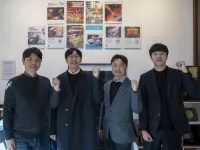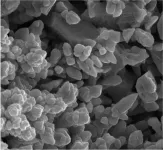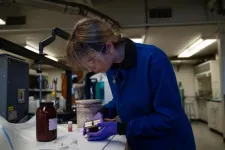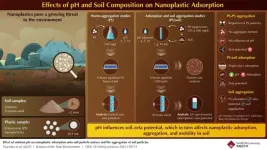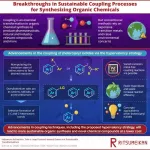(Press-News.org) The Korea Institute of Energy Research (President Yi Chang-keun, hereinafter referred to as “KIER”) has successfully developed ultra-lightweight flexible perovskite/CIGS tandem solar cells and achieved a power conversion efficiency of 23.64%, which is the world’s highest efficiency of the flexible perovskite/CIGS tandem solar cells reported to date. The solar cells developed by the research team are extremely lightweight and can be attached to curved surfaces, making it a promising candidate for future applications in buildings, vehicles, aircraft, and more.
Crystalline silicon-based single-junction solar cells are predominantly used in solar power generation due to their low production cost and suitability for mass manufacturing. However, as the efficiency of single-junction solar cells approaches their theoretical limit, tandem solar cells— which combine silicon with perovskite* solar cells to enhance efficiency—are gaining increasing attention.
* Perovskite: A material with a crystal structure similar to calcium titanate (CaTiO₃), known for its excellent light absorption properties, making it a promising next-generation solar cell material.
Currently, perovskite/silicon tandem solar cells have achieved efficiencies as high as 34.6%. However, their heavy weight and susceptibility to physical damage limit their application in fields where lightness and adaptability are critical, such as in automobiles, aircraft, and satellites.
To overcome these limitations, flexible thin-film perovskite/CIGS* tandem solar cells are being developed. CIGS-based thin-film solar cells are extremely lightweight and flexible, making them well-suited for use on curved surfaces such as buildings, vehicles, and aircraft. However, their lower efficiency and greater manufacturing complexity compared to perovskite/silicon tandem solar cells have posed barriers to commercialization.
*CIGS: A compound semiconductor made of copper, indium, gallium, and selenium (CuIn₁₋ₓ GaₓSe₂), known for its excellent photoelectric properties. It is used as a light-absorbing layer in thin-film solar cells. In particular, it can be fabricated on highly flexible substrates such as polyimide or metal films, giving it exceptional flexibility.
To enhance the manufacturability, flexibility, and lightness of tandem solar cells, the KIER research team developed a simple lift-off process and identified the underlying mechanisms behind the performance improvement. As a result, the fabricated perovskite/CIGS tandem solar cell achieved a power conversion efficiency of 23.64%, representing the highest recorded efficiency among flexible perovskite/CIGS tandem solar cells reported to date.
The lift-off process developed by the research team involves coating a polyimide layer onto a glass substrate, fabricating the perovskite/CIGS tandem solar cell on top of it, and then separating it from the glass. Unlike conventional methods that use flexible polyimide film directly as the substrate, this approach utilizes rigid glass as a supporting base, allowing for more stable fabrication of the solar cells. The use of a flat, rigid glass substrate also ensures uniform layer deposition, leading to improved device performance and higher reproducibility.
The research team also identified a method to enhance performance by reducing defects in the solar cell. During the fabrication process, alkali metal elements such as potassium diffuse from the glass substrate into the CIGS light-absorbing layer. Excessive diffusion of potassium can create defects within the absorber layer that hinder charge transport, ultimately degrading the performances of the solar cells. However, until now, no technology had been reported that effectively suppresses the diffusion of potassium to an optimal level.
Using computational science, the research team predicted that the polyimide layer coated on the glass substrate could suppress potassium diffusion. When applied to the solar cell fabrication process, this approach effectively reduced defects in the CIGS light-absorbing layer. As a result, the fabricated device achieved a power conversion efficiency of 23.64%, significantly exceeding the previous record of 18.1% for flexible perovskite/CIGS tandem solar cells.
In addition, to verify the durability of the fabricated CIGS solar cells, the research team measured the mechanical properties of the materials and analyzed the stress applied during bending through simulations. After conducting 100,000 bending cycles, the solar cells maintained 97.7% of their initial efficiency, demonstrating excellent durability.
Dr. Inyoung Jeong, who led the study, stated, “This research is a key achievement that demonstrates the commercial potential of next-generation high-efficiency solar cell technology with flexibility and lightness,” adding, “It serves as an important milestone toward realizing ultralight, flexible solar cells with 30% efficiency in the future.”
Dr. Kihwan Kim, principal investigator of the study, stated, “The power-to-weight ratio of the fabricated solar cell is approximately 10 times higher than that of perovskite/silicon tandem solar cells, making it highly promising for applications in fields that require ultralight solar modules, such as building exteriors, vehicles, and aerospace.” He added, “By advancing large-area fabrication processes and improving stability, we aim to strengthen the competitiveness of related industries and significantly contribute to the expansion of renewable energy adoption.”
Meanwhile, this research was published in the March issue of Joule (Impact Factor: 38.6), a prestigious international journal in the field of energy and materials. The study was conducted with support from the Research and Development Program of the Korea Institute of Energy Research, in collaboration with Professor Tae Kyung Lee of Gyeongsang National University and Professor Hae-Jin Kim of Yonsei University.
END
Lighter and more flexible solar cells achieve world’s highest efficiency
KIER achieves world’s highest efficiency of 23.64% with flexible perovskite/CIGS thin-film tandem solar cell
2025-04-09
ELSE PRESS RELEASES FROM THIS DATE:
Vehicle-mounted wireless power transfer: ensuring safety through magnetic field management
2025-04-09
A comprehensive study has examined the magnetic field emissions (MFE) from vehicle-mounted wireless power transfer (WPT) systems, providing critical insights for ensuring user safety during electric vehicle charging. As wireless charging technology gains popularity for fleet vehicles and accessibility applications, understanding and controlling electromagnetic field exposure becomes increasingly important.
Researchers conducted extensive physical measurements around a vehicle equipped with an in-house designed WPT system, examining how various factors affect magnetic field emissions where users might be positioned during charging operations. The study specifically investigated:
- ...
Finding cancer’s ‘fingerprints’
2025-04-09
Cancer diagnoses traditionally require invasive or labor-intensive procedures such as tissue biopsies. Now, research published in ACS Central Science reveals a method that uses pulsed infrared light to identify molecular profiles in blood plasma that could indicate the presence of certain common cancers. In this proof-of-concept study, blood plasma from more than 2,000 people was analyzed to link molecular patterns to lung cancer, extrapolating a potential “cancer fingerprint.”
Plasma is the liquid portion of blood, depleted of any ...
Starch-based microplastics could cause health risks in mice, study finds
2025-04-09
Wear and tear on plastic products releases small to nearly invisible plastic particles, which could impact people’s health when consumed or inhaled. To make these particles biodegradable, researchers created plastics from plant starch instead of petroleum. An initial study published in ACS’ Journal of Agricultural and Food Chemistry shows how animals consuming particles from this alternative material developed health problems such as liver damage and gut microbiome imbalances.
“Biodegradable starch-based plastics may not be as safe and health-promoting as originally assumed,” ...
A step toward cleaner iron extraction using electricity
2025-04-09
Iron and its alloys, such as steel and cast iron, dominate the modern world, and there’s growing demand for iron-derived products. Traditionally, blast furnaces transform iron ore into purified elemental metal, but the process requires a lot of energy and emits air pollution. Now, researchers in ACS Energy Letters report that they’ve developed a cleaner method to extract iron from a synthetic iron ore using electrochemistry, which they say could become cost-competitive with blast furnaces.
"Identifying oxides which can be converted to iron metal at low temperatures is an important ...
University of Oregon scientists advance a greener way to produce iron
2025-04-09
University of Oregon chemists are bringing a greener way to make iron metal for steel production closer to reality, a step towards cleaning up an industry that’s one of the biggest contributors to carbon emissions worldwide.
Last year UO chemist Paul Kempler and his team reported a way to create iron with electrochemistry, using a series of chemical reactions that turn saltwater and iron oxide into pure iron metal.
In their latest work, they’ve optimized the starting materials for the process, identifying which kinds of iron oxides will make the chemical reactions the most cost-effective. That’s a key ...
Nanoplastics in soil: how soil type and pH influence mobility
2025-04-09
Plastics are everywhere—from packaging and textiles to electronics and medical devices. As plastic waste breaks down, it releases microscopic particles that can penetrate our ecosystems, hinder plant growth, and potentially transfer harmful pollutants to organisms, including humans. Therefore, these plastic particles are a potential threat to the ecosystem, especially in their nanoparticulate form (1–100 nm diameter), which can penetrate the environment through different routes, including the soil beneath our feet.
With this in mind, a team of researchers from Japan set out to study the migration behavior of nanoplastics ...
Rethinking coupling methods for more sustainable organic synthesis
2025-04-09
Coupling reactions are among the most transformative tools in organic chemistry, enabling the formation of crucial chemical bonds in pharmaceuticals, agrochemicals, and advanced materials. Since their introduction, they have been one of the backbones of modern organic synthesis. However, these methods have long relied on environmentally taxing transition metal catalysts, such as palladium, which are often scarce, costly, and generate unwanted byproducts.
The limitations of conventional coupling methods have prompted researchers to seek alternative strategies that better align with the principles of green and sustainable chemistry ...
UN University: five deep changes urgently needed for a sustainable world and how to achieve them
2025-04-09
Amid deepening inequalities and escalating crises, including climate change, biodiversity loss and pollution, a new United Nations report presents a bold approach for change.
The 2025 Interconnected Disaster Risks report, Turning Over a New Leaf, issued by the UN University’s Institute for Environment and Human Security (UNU-EHS), shifts focus from diagnosing problems to mapping out solutions. It establishes that many of today’s solutions are surface-level fixes, and that to create ...
Ohio State study reveals new insights into neurodegeneration using human ‘mini brains’
2025-04-09
COLUMBUS, Ohio – Researchers at The Ohio State University Wexner Medical Center and College of Medicine have discovered a new way that neurons act in neurodegeneration by using human neural organoids – also known as “mini-brain” models – from patients with frontotemporal lobar degeneration (FTLD).
Understanding this new pathway could help researchers find better treatments for FTLD and Alzheimer’s, the two most common forms of dementia that lead to cognitive decline.
Researchers used advanced techniques to study neurons from ...
Decarbonization improves energy security for most countries, Stanford study finds
2025-04-09
A pivot from fossil fuels to clean energy technologies by 2060 would improve energy security and reduce trade risks for most nations, according to an April 9 study in Nature Climate Change.
Lithium, nickel, cobalt, copper, and rare earth minerals are among the prized materials for countries and corporations racing to secure supplies for energy systems that do not add greenhouse gases to our atmosphere. Unlike fossil fuels, natural reserves of these materials are most concentrated in the Global South, shuffling the geopolitics of energy and global trade.
“Most people ...
LAST 30 PRESS RELEASES:
University of Oklahoma researcher awarded funding to pursue AI-powered material design
Exploring how the visual system recovers following injury
Support for parents with infants at pediatric check-ups leads to better reading and math skills in elementary school
Kids’ behavioral health is a growing share of family health costs
Day & night: Cancer disrupts the brain’s natural rhythm
COVID-19 vaccination significantly reduces risk to pregnant women and baby
The role of vaccination in maternal and perinatal outcomes associated with COVID-19 in pregnancy
Mayo Clinic smartwatch system helps parents shorten and defuse children's severe tantrums early
Behavioral health spending spikes to 40% of all children’s health expenditures, nearly doubling in a decade
Digital cognitive behavioral treatment for generalized anxiety disorder
Expenditures for pediatric behavioral health care over time and estimated family financial burden
Air conditioning in nursing homes and mortality during extreme heat
The Alps to lose a record number of glaciers in the next decade
What makes a good proton conductor?
New science reporting guide published for journalists in Bulgaria
New international study reveals major survival gaps among children with cancer
New science reporting guide published for journalists in Turkey
Scientists develop a smarter mRNA therapy that knows which cells to target
Neuroanatomy-informed brain–machine hybrid intelligence for robust acoustic target detection
Eight SwRI hydrogen projects funded by ENERGYWERX
The Lundquist Institute and its start-up company Vitalex Biosciences Announces Strategic Advancement of Second-Generation fungal Vaccine VXV-01 through Phase 1 Trials under $40 Million Competitive Con
Fine particles in pollution are associated with early signs of autoimmune disease
Review article | Towards a Global Ground-Based Earth Observatory (GGBEO): Leveraging existing systems and networks
Penn and UMich create world’s smallest programmable, autonomous robots
Cleveland researchers launch first major study to address ‘hidden performance killer’ in athletes
To connect across politics, try saying what you oppose
Modulating key interaction prevents virus from entering cells
Project explores barriers to NHS career progression facing international medical graduates
Jeonbuk National University researchers explore the impact of different seasonings on the flavor perception of Doenjang soup
Two Keck Medicine of USC Hospitals named Leapfrog Top Teaching Hospitals
[Press-News.org] Lighter and more flexible solar cells achieve world’s highest efficiencyKIER achieves world’s highest efficiency of 23.64% with flexible perovskite/CIGS thin-film tandem solar cell
